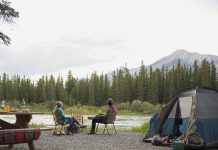Camping is one way to escape the hustle and bustle of urban life. Outdoors are a lot of fun, but camping is a different ball game. Eco-friendly camping is the latest upgrade for camping enthusiasts. It is all about minimizing your impact on the environment while enjoying yourself in the outdoors. Here are is a step-wise guide to becoming an eco-friendly camper.

1.    Take your junk back
Campers are known to cause maximum damage to the environment by leaving their litter behind. Hence this is the first step to eco-friendly camping. While packing for your outdoor camping trip, ensure that you pack bags that will come handy in carrying the trash back with you. This is not only true for plastic and other non-degradable items, but also for food. Though food waste is biodegradable, it is sure to attract animals to the camp sites or the trail paths, which will endanger fellow campers and hikers. Pack all your unused food items and take them back with you.
2.    Go solar
Camping in the wilderness without lights might be quite a misadventure and many of the campers have been using gas-powered generators so far. This not only pollutes the natural environs with the noise and gas. With advances in technology, solar power can be tapped in by carrying a solar panel on your RV. This power will enable you to keep all your gadgets charged while helping keep the tranquility of the natural surroundings.
3.    Choosing the right spot
In many national parks, camping sites are pre-designated and take into consideration all the necessary precautions. But there are some others which have very broadly classified camping spots within the park. In such situations it is recommended that you choose a spot that is at least 200 ft. away from trails and water bodies. This way you could avoid contact with the wild life and disturbances from fellow campers. Also make it a point not to use the streams for washing and brushing as the detergents and pastes throw the natural ecosystem out of gear.
4.    Observe restraint while using fire
Burning wood for campfires is an inseparable part of any camping trip. But we suggest use of restraint while doing so. Use already fallen timber from the forest floor in place of cutting a tree. One can use dust in place of water to put the fire out. But make sure that the wood has burned down completely into ash, before doing so. Alternatives to keeping yourselves warm are use of extra warm clothing; and for cooking the best alternative is camping stoves. It is advisable to bring your lanterns for lighting. The idea is not to dilute your fun, but to be responsible to the very environs that gives you joy.
5.    Take only memories back
Many of us like to carry back souvenirs of the place we visit. So is the case when we go camping. But remember that our national parks are not souvenir shops. Take pictures, smell the flowers and take in the beauties of our natural world. By not carrying anything from the camping sites you help retain the delicate balance of these ecosystems. So taking back memories is a big step towards eco-friendly camping.








